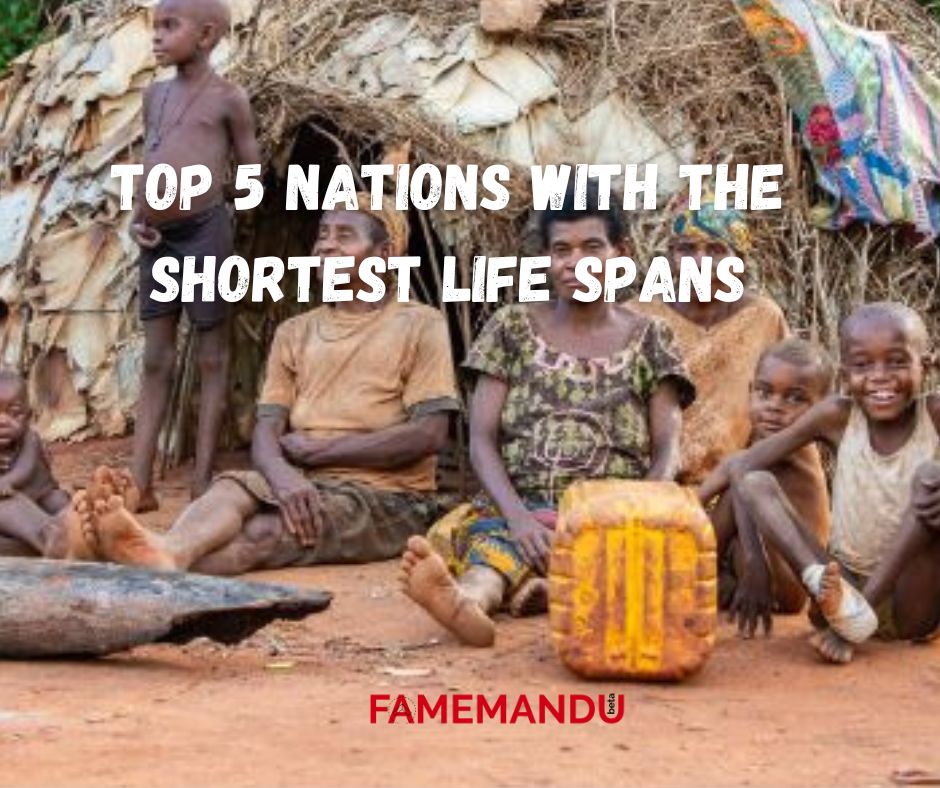1. Central African Republic (53-54 years)
August 13, 1960, saw the Central African Republic, a landlocked nation in Central Africa, declare its independence from France. The country has experienced economic difficulties due to its turbulent past, which was characterized by political unrest and violence. The average life expectancy in 2023 is projected to be between 53 and 54 years, which reflects the effects of continuous problems and healthcare constraints. Socioeconomic divides exist among the inhabitants of the Central African Republic, where a sizable section of the populace depends on subsistence farming. In order to increase the well-being and life expectancy of its population, efforts must be made to stabilize the political environment and upgrade the healthcare system.

2. Chad (54 years)
The life expectancy of Chad, a landlocked nation in Central Africa, is projected to be 54 years as of 2023. There are a number of factors that contribute to this comparatively short life duration, such as a lackluster healthcare system, common diseases, and socioeconomic difficulties. Chad’s population has faced periods of political unrest and conflict, which has made it more difficult to provide reliable healthcare services. Health results are further impacted by limited access to education, sanitary facilities, and clean water. In order to increase life expectancy and general well-being in Chad, it is imperative that initiatives to improve healthcare accessible, boost education, and address socioeconomic inequities be made. Addressing these issues requires both domestic strategies for sustainable development and international cooperation.

3. Lesotho (54 years)
Lesotho is a landlocked nation in Southern Africa, and as of 2023, its life expectancy is roughly 54 years. Significant health issues confront the country, such as a high rate of HIV/AIDS, TB, and restricted access to medical care. The comparatively low life expectancy is a result of socioeconomic issues like hunger, poverty, and inadequate infrastructure. The steep topography of Lesotho makes access to healthcare difficult. Improving healthcare facilities, tackling social and economic disparities, and fighting the HIV/AIDS epidemic are all essential to raising life expectancy and general well-being in Lesotho. In order to address these health and development concerns, tailored domestic policies and international support are essential.

4. Nigeria (54 years)
As of the latest available data, Nigeria has a life expectancy of approximately 54 years. This populous West African country faces health challenges such as infectious diseases, limited healthcare access in certain regions, and socio-economic disparities. Factors like poverty and inadequate infrastructure contribute to the relatively lower life expectancy. Nigeria’s diverse population, cultural richness, and economic potential contrast with health and development challenges. Efforts to improve healthcare infrastructure, address public health issues, and implement socio-economic reforms are crucial for enhancing life expectancy and overall well-being. Ongoing initiatives seek to tackle these challenges and promote sustainable development in Nigeria.

5.Sierra Leone (54-55 years)
Sierra Leone faces a life expectancy of roughly 54–55 years as of 2023. This country in West Africa has had to deal with issues like a long history of civil unrest, dangerous illnesses like Ebola, and restricted access to medical care. The impact of these variables on life expectancy is mostly responsible for the relative decline. There are ongoing initiatives to repair the healthcare system, deal with illness prevention, and enhance socioeconomic circumstances. The population of Sierra Leone is better off generally, and their life expectancy is higher thanks in large part to both domestic and international initiatives. The goal of ongoing initiatives is to promote sustainable development and resilience in the face of past and present difficulties.

At last Low life spans can be caused by a number of things, such as poor health care systems, common diseases, poverty, malnutrition, and socioeconomic inequality. Restricted availability of sanitary facilities, education, and clean water also have a big impact. Mortality rates can also be made worse by violent conflicts, unstable political environments, and inadequate public health interventions. The load is increased by the high prevalence of infectious diseases such malaria, HIV/AIDS, and tuberculosis. The intricate interactions between environmental, socioeconomic, and health factors differ throughout countries and areas, which leads to variations in life expectancy. Increasing life expectancy and fostering general well-being requires strengthening healthcare systems, tackling poverty, guaranteeing education, and putting into practice efficient public health initiatives.



Comments